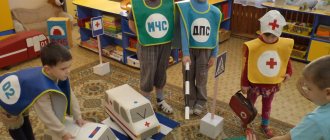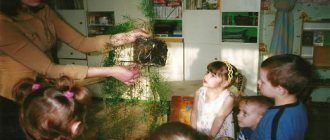Plot-role-playing game for preschoolers. article (senior group) on the topic
The structure of a plot-role-playing game.
A role-playing game has the following structural components: - plot;
- content;
— role [17].
Let's look at each of these structural components.
A) The plot of the game.
The main component of a role-playing game is the plot; without it, there is no role-playing game itself.
The plot is the sphere of reality that is reproduced by children. The plot is a child’s reflection of certain actions, events, relationships from the life and activities of those around him. At the same time, his playful actions (turning the steering wheel of a car, preparing lunch, teaching students how to draw, etc.) are one of the main means of realizing the plot.
The plots of the games are varied. They are conventionally divided into:
- household (family games, kindergarten);
- production ones, reflecting the professional work of people (games of hospital, store, livestock farm);
- public (games to celebrate the city’s birthday, to the library, to school, to fly to the moon) [8].
B) Game content. Changes in content depending on the age of the children.
The content of the game, notes D.B. Elkonin, is what is reproduced by the child as a central and characteristic moment of activity and relationships between adults in their everyday, work, and social activities [6].
Depending on the depth of the child’s ideas about the activities of adults, the content of the games also changes.
In terms of content, the games of children of primary preschool age differ from the games of older children. These differences are associated with the relative limitations of experience, features of the development of imagination, thinking, and speech. The child cannot imagine the game before it starts and does not grasp the logical sequence between real events [7]. Therefore, the content of the games, as A.P. Usova noted, is fragmentary and illogical. Children often repeat in play actions with toys shown by adults and related to everyday life: fed the bear - put him to bed; fed him again and put him to bed again. A.P. Usova characterized such games as action games [17].
However, at the border between the third and fourth years of life, games become more meaningful, which is associated with the expansion of children’s ideas about the world around them. Preschoolers begin to combine different events, including in games episodes from their own experience and from literary works that were read to them or, which is especially valuable, shown through plot-didactic games, illustrations in books, table theater, and filmstrips.
In the fourth and fifth years of life, the integrity of the plot and the interconnectedness of the reflected events are observed in children’s games. Preschoolers develop an interest in certain scenes that they have played with before (family, hospital, construction workers, transport, etc.). Children respond vividly to new experiences, weaving them like storylines into familiar games. The enrichment of content is facilitated by the interaction of children in the game, when everyone contributes something of their own, individual.
Children of senior preschool age thoughtfully approach the choice of plot, discuss it in advance, and plan the development of the content at an elementary level. New stories are appearing that are inspired by impressions gleaned outside the preschool: based on animated series, books read at home, stories from parents, etc.
In older and preschool age, generalization of play situations continues; in addition to conditional and symbolic actions (put his head on his palm - he fell asleep), children actively use verbal comments (“Everyone seems to have slept - and we’ll immediately go to the hall for the holiday!”; “Let’s do this: we’ve already arrived in Africa!”). These speech comments are a verbal replacement of any events [2]. Children resort to them so as not to violate the logic of the unfolding of the game’s content.
Thus, throughout preschool childhood, the development and complication of the content of the game is carried out in the following directions [1]:
- strengthening the purposefulness, and therefore the consistency and coherence of what is depicted;
- a gradual transition from an expanded game situation to a collapsed one, generalization of what is depicted in the game (the use of conditional and symbolic actions, verbal substitutions).
The variety of content of role-playing games is determined by children’s knowledge of those aspects of reality that are depicted in the game, the consonance of this knowledge with the interests, feelings of the child, and his personal experience. Finally, the development of the content of games depends on the child’s ability to identify characteristic features in the activities and relationships of adults.
B) Role in the game. Role changes as children age.
The content of the role-playing game is embodied by the child through the role he takes on. A role is a means of realizing the plot and the main component of a role-playing game [8].
For a child, a role is his playing position: he identifies himself with a character in the plot and acts in accordance with his ideas about this character. Every role contains its own rules of behavior, taken by the child from the surrounding life, borrowed from relationships in the adult world. Submission of the child to the rules of role-playing behavior is the most important element of role-playing play. Deviation of any of the players from these rules causes protests from the playing partners. Thus, for preschoolers, a role is an example of how to act. Based on this sample, the child evaluates the behavior of the participants in the game, and then his own.
Throughout preschool childhood, the development of role in role-playing games occurs from the performance of role-playing actions to role-images. For younger preschoolers, everyday activities predominate: cooking, bathing, washing, driving, etc. Then role designations associated with certain actions appear: I am a mother, I am a driver, I am a doctor.
In middle preschool age, playing a role becomes a significant motive for play activity: the child develops a desire not just to play, but to fulfill one or another role. The point of the game for a 4-5 year old preschooler is the relationships between the characters. Therefore, the child willingly takes on those roles in which the relationships are clear to him (the teacher takes care of the children, the captain steers the ship, makes sure that the sailors work well and that the passengers are comfortable). At this age, role speech becomes a means of interaction.
In older preschool age, the meaning of the game lies in the typical relationships of the person whose role is played by the child with other persons whose roles are taken on by other children. In games, role-playing dialogues appear, with the help of which the relationships between characters are expressed and game interaction is established. For the quality of role performance, the child’s attitude towards it is important. Therefore, it should be borne in mind that older preschoolers are reluctant to perform roles that, in their opinion, do not correspond to their gender. When performing a role, the child takes into account not so much the external logic, the sequence of actions (there is a free runway at the airfield, which means the plane can land), but the meaning of social relations (the runway is free, but you need to ask the dispatcher so that an accident does not happen).
Used Books .
1. Boychenko HA et al. Role-playing games for preschoolers. - Kyiv: Radyanska School, 1982.
2. Valitova I.E. Psychology of development of a preschool child. -Minsk, 1997
3. Zaporozhets A.V., Elkonin D.B. Psychology of preschool children. - M.: Mysl, 1989.
4. Zvorygina E.V. The first story-based games for kids. - M.: Radug
5.Kozlova S.A. Preschool pedagogy: a textbook for students / S.A. Kozlova, T.A. Kulikova. - M.: Publishing House, 2007. a, 1988.
6.Psychology and pedagogy of preschooler play. // Ed. A.V.Zaporozhets, A.P.Usova. - M.: Mysl, 1986.
Story-based play as a means of developing a psychologically healthy child
Natalia Grishkina
Story-based play as a means of developing a psychologically healthy child
Story play in Russian psychology and pedagogy is considered as the leading activity of children
preschool age (A. N. Leontyev, D. B. Elkonin, etc.).
With a special organization of the pedagogical process, a story game
becomes one of the main means contributing to normal mental development, the disclosure of individual and personal potentials of children, and, therefore, acts as a means of becoming a psychologically healthy child.
Story game
can act as a means of becoming a psychologically healthy child (as opposed to mentally healthy) only if it is organized in such a way that it allows children to achieve not only age-related norms for the development of the game as a specific children's activity, but also to realize their individual preferences in the development of its plot.
By older preschool age, children's story-based play becomes a complex formation in which different components of the game are used and intertwined - actions/events and their sequences, roles and role-playing interactions, game objects and their organization. The child improves his ability for substitutive action - from objective to purely verbal substitution, and acquires the ability to build plot combinations characterized by increasing internal coherence, regardless of whether the theme of the plot is realistic or fantastic (fictional).
At the same time, there are significant differences between children who have reached this stage (stage) of play. These differences cannot be qualified as a manifestation of a higher or lower stage (stage) of the game, but exist as variants of the manifestation of stage (stage) characteristics.
In other words, the plot play of older preschoolers appears not only in terms of general characteristics, but also in a differentiated form.
In the play of older preschoolers, there are differences regarding the nature of the development of the plot, the connection of the components of the plot, and the use of game material as a means of embodying the plot. This is evidenced by observations of children’s play recorded by various psychologists (A. N. Leontiev, N. A. Menchinskaya, V. S. Mukhina, J. Piaget, D. Selley, etc.).
These kinds of differences in the play of older preschoolers are associated with emphasis on one or another component of the children's plot, which entails the need and nature of the use of the material.
Peculiarities in the development of a coherent plot of a game, to the extreme degree of expression, form, as it were, two “poles”: the first is the emphasis in the plot of temporary connections, realized through the development and designation of the sequence of events occurring with the character (role); the second is the emphasis in the plot of subject-spatial connections - the space for the implementation of events, the actions of a character (role) through the creation and designation of a subject-spatial environment.
In creating an object-game environment
An important task arises - to organize the joint play of children and support it, that is, to find for small game material an actual holistic subject field, which will determine, on the one hand, the coherence of the structural components of the plot, on the other hand, to connect the individual plans of children into a single event -spatial field. In the cultural layer of game objects used in children's play, there are specific toys that define such an integral field: game models (N. A. Korotkova, I. L. Kirillov).
By game layout we mean a reduced object sample of space and objects of an imaginary world (realistic or fantastic). However, in real implementation, models usually exist in conjunction with other plot-forming materials: character figures, individual space markers, objects indicating character events (for example, Lego models).
A thematic set of game material, as can be seen in children’s play, “contains”, offers a functional scheme for the development of the plot, imposing on children a certain theme of the plot, which makes it easier for children to unfold the event plan, helps to “generate” the game plan itself, but can restrain individual freedom in the game .
Why do preschoolers need games?
In the first 5-6 years, a child studies everything that surrounds him, gets acquainted with new phenomena, and forms his own opinion. It is at this time that habits and skills are formed, which in the future will be the basis of character. Thanks to games, children learn a lot of new things, draw their own conclusions, learn to communicate, and expand their horizons and worldview. Role-playing games that help to master communication skills are important. The child learns to communicate with other children, express his point of view, and transform into a person of a certain profession or social status.
What are the benefits of role-playing games:
- The child's personality develops.
- Cognitive processes are activated.
- Kids try on various social roles.
- Children learn to interact with other players.
- The child must follow certain rules of the game.
- Self-discipline develops.
- Creative potential is being developed.
- Games help intellectual development.
- The speech apparatus improves.
Role-playing games in preschool educational institutions. The role of play in a child's life.
We are having fun
Goal:
to attract children to participate in humorous fun, to develop independence skills in organizing and preparing fun, to promote the unification of children, to develop the emotional sphere of the child, to cultivate optimism, love of life, a sense of teamwork, and mutual assistance.
Equipment:
everything necessary that a child can use to improvise pranks and attractions.
Age:
5–6 years.
Progress of the game:
The teacher invites the children to organize a competition. You can come up with and show a funny story, a fable, show a trick, etc. A jury is selected to evaluate the result. After each performance they give their ratings. At the end of the game, the points are tallied and the winner is announced. He is awarded the “Veselchak” medal.
In the cafe
Target:
teach a culture of behavior in public places, be able to perform the duties of a cook and waiter.
Equipment:
necessary equipment for the cafe, toys-dolls, money.
Age:
5–6 years.
Progress of the game:
Buratino comes to visit the children. He met all the children and made friends with other toys. Pinocchio decides to invite his new friends to a cafe to treat them to ice cream. Everyone goes to the cafe. There they are served by waiters. Children learn to place an order correctly and thank you for the service.
Trip around the world
Target:
expand children's horizons, consolidate knowledge about parts of the world, different countries, cultivate a desire to travel, friendships, expand children's vocabulary: “captain”, “travel around the world”, “Asia”, “India”, “Europe”, “Pacific Ocean” "
Equipment:
ship made of building material, steering wheel, binoculars, world map.
Age:
6–7 years old.
Progress of the game:
The teacher invites the children to go on a trip around the world by ship. If desired, children are chosen for the roles of Captain, Radio Operator, Sailor, Midshipman. We consolidate knowledge about what these people do on the ship - their rights and responsibilities. The ship sails through Africa, India, and other countries and continents. Sailors have to deftly steer the ship so as not to collide with an iceberg and cope with the storm. Only well-coordinated work and friendship help them cope with this test.
On city roads
Target:
consolidate children's knowledge about the rules of the road, introduce them to a new role - a traffic controller, cultivate self-control, patience, and attention on the road.
Equipment:
toy cars, flags for traffic controllers - red and green.
Age:
5–7 years.
Progress of the game:
children are offered to build a beautiful building - a theater. We choose a place to build. But first you need to transport the building material to the right place. Car drivers can easily cope with this. Children take cars and go to get building materials. But here’s the bad news: the traffic lights don’t work on the main roads. To avoid an accident on the road, it is necessary for the traffic of cars to be controlled by a traffic controller. Select a Regulator. He forms a circle. He holds red and green flags in his hands. A red flag means “stop”, a green flag means “go”. Everything will be alright now. The traffic controller controls the traffic.
Role-playing games for children 4-5 years old
At this age, it is important for children to choose the role that they like best. Dialogues with other participants, through which information and emotions are exchanged, are important in the process. Preschoolers are able to come up with a coherent plot with the development of events, and distribute roles between the participants. They enjoy fantasizing and coming up with interesting stories.
Suitable games for preschoolers:
- "Circus";
- "In Space";
- "In the restaurant";
- "Journey to Another Continent";
- "ONE HUNDRED";
- "Airplane";
- "On the ship", and much more.
What moms say
Maria, mother of four-year-old Dasha: “My daughter loves to play with dolls. We come up with different stories: the mother goes for a walk with the child, feeds the baby, bathes, and changes clothes. It’s so touching to watch how Dasha feeds the baby doll porridge in the morning and sits him in a toy chair. Then he rolls along the street in a stroller, bathes him in a toy bubble bath in the evening, and wraps him in a towel. I believe that such games prepare children for later life, because one day Dashenka will raise her own child.”
Olga, mother of five-year-old Miroslav: “Friends often come to visit my son, and they play construction together: they build buildings from blocks or construction sets. They often play hospital, where one of the children becomes a doctor, and the rest voice the toys who are sick and need help.
I know that role-playing games are important for children’s development, so I come up with interesting stories myself. For example, we recently staged a theatrical performance: we wrote a script, seated teddy bears on chairs, and turned on music. Miroslav really enjoyed performing “on stage.”
Parents should remember that role-playing games are important in the development of intelligence, as well as communication and creative skills in children.
It is necessary to encourage in every possible way the child’s desire to play “Daughters-Mothers” or “Hospital”, as well as come up with new storylines in which the child can learn something new. leave a comment






